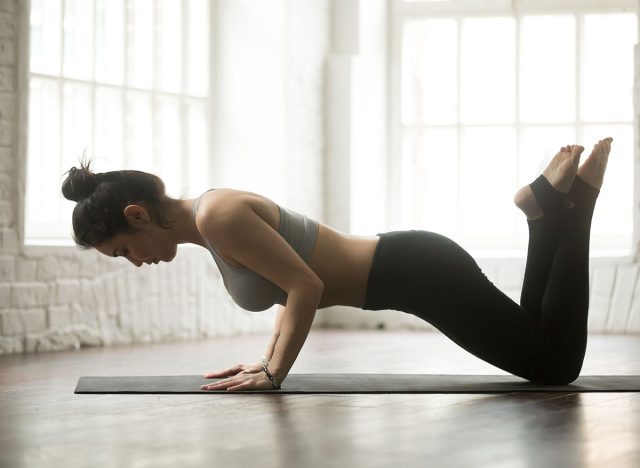Over 50? If You Can Do This Many Knee Pushups, Your Upper Body Is Stronger Than Most

Pushups are a classic bodyweight exercise that are a staple in many fitness routines—for good reason. Not only are they low-impact when done with solid form, but they’re also an excellent way to test your upper-body strength and overall fitness level—especially as you age. There are many modifications you can perform, such as wall or knee pushups. We spoke with an expert to learn just how many knee pushups signal peak upper-body strength.
The Importance of Upper-Body Strength After 50

Building and maintaining a strong upper body is essential as you age. Starting in your 30s, you lose lean muscle mass—anywhere from 3% to 8% per decade. Sarcopenia only speeds up after 50, majorly impacting how you move, your metabolism, and your energy levels.
According to Felicia Hernandez, NASM-certified personal trainer and community engagement lead at Eden Health Club, pushing strength tends to decline quicker because most people stop performing exercises and movements that specifically challenge those muscles. The good news is, with regular strength training, you can preserve or rebuild it at any stage of life.
“Your ability to move and live well during aging depends heavily on your upper-body strength,” explains Hernandez. “The post-50 years bring a shift from physical appearance concerns to life energy preservation. The muscles in your arms and shoulders, and chest work together to support your posture and joint protection while making basic activities like grocery lifting and chair standing, and grandchild carrying feel effortless instead of tiring. Your ability to perform daily tasks depends on your muscle strength levels.”
What Makes Knee Pushups a Solid Benchmark for Those 50+
Knee pushups are considered to be one of the most accessible and revealing tests of upper-body control and endurance.
“The muscles of your chest, triceps, shoulders, and core work together during knee pushups to help you perform door pushing and floor rising activities,” Hernandez explains. “The exercise requires no special equipment or gym membership. The test provides an accurate assessment of your body’s ability to support your daily activities. Your overall muscle balance and resilience become evident when you perform knee pushups with proper technique.”
If You Can Do This Many Knee Pushups, Your Upper Body Is Stronger Than Most

Now, exactly how many knee pushups are a telltale sign of upper-body strength?
According to Hernandez, “The achievement of 15 to 20 knee pushups with proper technique serves as an excellent indicator of strength for most people. The number of 10 knee pushups indicates you are on the right path toward building functional endurance, although you need to maintain consistency for further progress.”
That said, the number of reps you’re able to complete becomes substantially less important if you’re unable to control your movement. Quality is more of a priority than the number of reps as you age, Hernandez stresses.
How Knee Pushups Measure Real-World Functional Strength

Your ability to perform knee pushups directly correlates to everyday tasks.
“The core stabilizing motion and arm driving action during knee pushups enable you to perform activities such as floor push-offs and heavy door opening, and grocery load stabilization,” notes Hernandez. “The true value of strength lies in your body’s ability to perform well during essential activities rather than achieving specific gym metrics. People who develop functional strength through training gain self-assurance to continue their preferred activities without worrying about performance restrictions.”